Homicide in Canada, 2007
Archived Content
Information identified as archived is provided for reference, research or recordkeeping purposes. It is not subject to the Government of Canada Web Standards and has not been altered or updated since it was archived. Please "contact us" to request a format other than those available.
By: Geoffrey Li
Canada's homicide rate continues to decline
Homicide rates highest in the west and the north
Homicide victims at equal risk of being shot or stabbed
Use of handguns to commit homicide increasing
One in five homicides were gang-related
Prostitutes at risk of being victims of homicide
The large majority of victims knew their attacker
Spousal homicides continue to decline
Males account for majority of homicide victims and those accused of homicide
Decline in youth accused of homicide follows peak in 2006
Summary
Detailed data tables
References
Notes
Homicides are a relatively rare occurrence in Canada and have been generally declining over the past 30 years. In 2007, homicides made up less than one percent of all violent crime in Canada. In fact, Canadians are about four times more likely to be killed in a traffic accident and about six times more likely to commit suicide than they are to be a victim of a homicide.1
In addition to being the most serious criminal offence, a country's homicide rate is often used as a barometer of the level of violence in that society. Homicide is also the only criminal offence that is truly comparable among nations. Compared to other countries, Canada's homicide rate continues to be about one-third that of the United States, but comparable to Australia, New Zealand and many European nations (Chart 1).
Chart 1
Homicide rates for selected countries

1. Figures reflect 2005 data.
2. Figures reflect 2007 data.
3. Figures reflect 2006 data.
Source: Statistics Canada, Interpol Ottawa and national statistical office websites
Canada's homicide rate continues to decline
Between the mid-1960s and mid-1970s, Canada experienced a sharp rise in homicides. The rate more than doubled over this period, from 1.25 homicides per 100,000 population in 1966 to 3.03 in 1975 (Chart 2).
Since then, Canada's homicide rate has generally been declining and is down 40% since 1975. This trend continued in 2007, with a further 3% decrease in the rate. The 2007 rate of 1.80 was similar to what it was in the late 1960s. (Table 1) The rate of attempted murder also declined in 2007, down 5% (Dauvergne, 2008).
Chart 2
Homicides peaked in mid-1970s
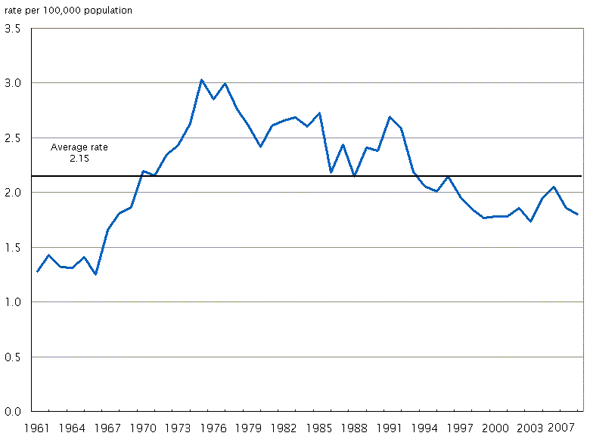
Source: Statistics Canada, Canadian Centre for Justice Statistics, Homicide Survey.
There were 594 homicides reported by police in 2007, 12 fewer than in 2006 (Table 2). This decline was seen in most provinces, with the largest being reported in British Columbia (20 fewer homicides) and Saskatchewan (12 fewer) (Chart 3).
The decline in homicides in British Columbia resulted in the second lowest homicide rate in that province since statistics were first collected in 1961 (1964 was the lowest ever recorded). Quebec's homicide rate was at its lowest point in over 40 years.
Chart 3
Highest homicide rates usually in Manitoba and Saskatchewan

Source: Statistics Canada, Canadian Centre for Justice Statistics, Homicide Survey.
Manitoba, however, was an exception to the general decline in 2007. With 62 homicides, 23 more than in 2006, Manitoba's homicide rate of 5.22 was the highest in that province since 1961. Most of the increase in Manitoba in 2007 occurred in small urban and rural areas. Manitoba also experienced a 53% increase in attempted murders in 2007 (Dauvergne, 2008).
Homicide rates highest in the west and the north
Over the past 10 years, the western provinces, particularly Manitoba and Saskatchewan, and the territories have consistently reported the highest homicide rates in the country. Last year was no exception, as the highest rate was in Manitoba, followed by Saskatchewan, Alberta and British Columbia. Prince Edward Island and Newfoundland and Labrador continue to report the lowest rates.
One consistent finding is that homicide rates in the nine largest census metropolitan areas2 (CMAs), over 500,000 population, are higher than in the smaller metropolitan areas with populations between 100,000 and 500,000 (Table 3). This was once again the case in 2007, where the rate in the larger metropolitan areas (2.07) was almost 50% higher than in the smaller metropolitan areas (1.45) (Chart 4).
Chart 4
Among the largest Census Metropolitan Areas homicide rates highest in the west
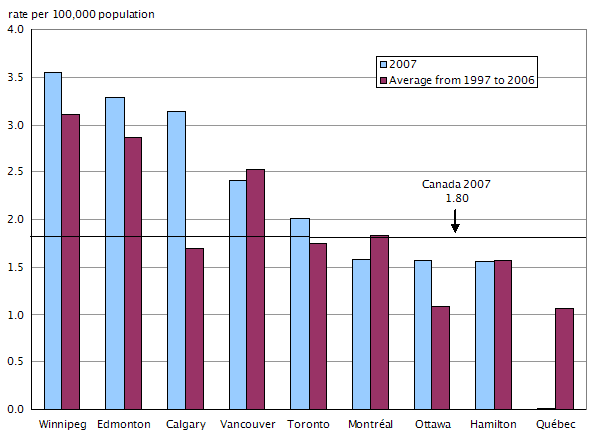
Source: Statistics Canada, Canadian Centre for Justice Statistics, Homicide Survey.
In 2007, three large metropolitan areas, all in western Canada, reported homicide rates in excess of 3.0 per 100,000 population: Winnipeg, Edmonton and Calgary. Saskatoon, although a smaller metropolitan area, actually reported the highest rate of all cities (3.60).
Toronto, Calgary and Trois-Rivières each reported their highest homicide rate since the early 1990s. Although almost one in every five homicides in the country occurred in Toronto in 2007, taking population into account, Toronto's rate ranked in the middle of the nine largest cities.
Calgary's rate in 2007 was much higher than the average of the previous 10 years, as the homicide rate there has increased sharply since 2003.
Quebec City reported having no homicides in 2007, marking the first time since CMA data were first available in 1981 that any metropolitan area with over 500,000 population did not have any homicides.
Homicide victims at equal risk of being shot or stabbed
For the past 20 years, Canadian homicide victims have been at equal risk of being shot or stabbed. This held true in 2007 as 190 homicide victims were stabbed and 188 were shot, with each method accounting for about one-third of all homicides (Table 4).
There were 116 victims killed by beating (20%), 50 by strangulation or suffocation (8%) and 16 by a motor vehicle (3%). This represented the most victims killed by an accused using a motor vehicle since these data were first collected in 1997.
The use of handguns to commit homicide increasing
Although the overall rate of homicides committed with a firearm has generally been declining since the mid-1970s, the use of handguns has generally been increasing since the mid-1980s. However, the use of rifles or shotguns continues to decline (Chart 5).
Of the 188 firearms used to commit homicide in 2007, two-thirds were handguns – 16 more than in 2006 (Table 5). There were also 32 homicides committed with rifles/shotguns and 17 with sawed-off rifles/shotguns in 2007, both down from 2006.
Chart 5
Use of rifles and shotguns continue to decline in 2007
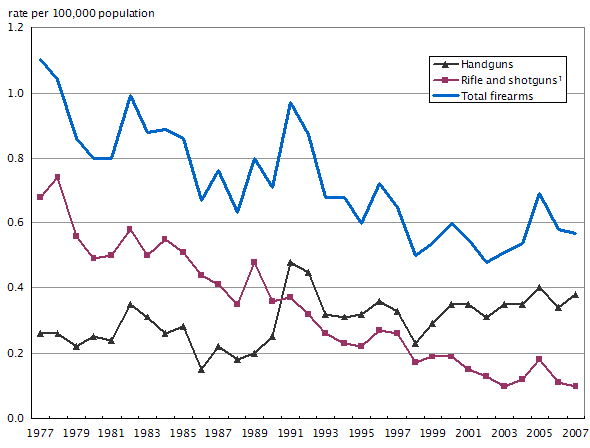
1. Excludes sawed-off rifles/shotguns.
Source: Statistics Canada, Canadian Centre for Justice Statistics, Homicide Survey.
Homicides committed with handguns are primarily an urban phenomenon. Within the nation's metropolitan areas, 81% of all firearm homicides were committed with a handgun in 2007, compared to 29% in the rest of Canada. Although Toronto recorded the highest number of handgun homicides, controlling for population, its rate was below those of both Vancouver and Edmonton.
One in five homicides were gang-related
Gang-related homicides, which include those of gang members as well as police officers and innocent bystanders, have been increasing since this information was first collected by the Homicide Survey in 1991 (Chart 6). In 2007, 117 homicides were reported by police as gang-related, accounting for about one in five homicides. The 2007 total was 16 more than in 2006 (Table 6).
Chart 6
Gang-related homicides on the increase
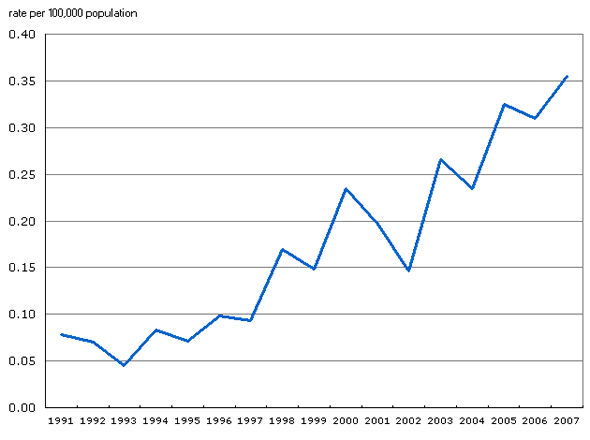
Source: Statistics Canada, Canadian Centre for Justice Statistics, Homicide Survey.
Firearms were used more often in gang homicides than in other types of murder. In 2007, 69% of gang-related homicides were committed with a firearm, compared to about 20% of homicides which did not involve gangs. In total, 43% of all homicides committed with a firearm last year were gang-related.
In Saskatchewan, 9 of the 30 homicides in 2007 were gang-related – the highest proportion among the provinces (30%). The Atlantic provinces (8%) and Ontario (14%) reported the lowest proportions of gang-related homicides.
Most gang-related homicides occurred within Canada's largest cities. The nine largest metropolitan areas accounted for about 60% of Canada's homicides in 2007, but more than three-quarters of all gang homicides. Edmonton reported the highest rate of any of these large cities.
Prostitutes at risk of being victims of homicide
In addition to gang-related homicides,3 there were 58 homicides in 2007 that were linked to illegal activities of the victim, such as the drug trade and prostitution, up from 40 the previous year. Police reported that 15 prostitutes were killed as a direct result of their profession in 2007,4 up from an average of 7 per year for the previous decade.
In comparison, it is less common to be a victim of homicide as a direct result of legal employment. On average, there have been 17 victims killed each year since 1997 while "on the-job". In 2007, there were eight legal occupation-related homicides, including four police officers. Since reporting began in 1961, an average of 3 police officers have been killed each year.
Taxi drivers have one of the highest at-risk homicide rates among legal occupations (de Léséleuc, 2007). Since 1997, an average of two taxi drivers have been killed each year while on the job, including one in 2007.
The large majority of victims knew their attacker
Most victims knew the person who killed them – in 2007, a relatively small proportion (16%) of solved homicides were committed by a stranger. The rate of homicides committed by a stranger has been fairly stable over the past 30 years (Chart 7).
Homicide victims in Canada are almost equally likely to be killed by a family member as they are an acquaintance. In 2007, of all solved homicides, about one-third of victims were killed by an acquaintance and a further one-third by a family member (Table 7).
Chart 7
Most homicides committed by someone known to victim
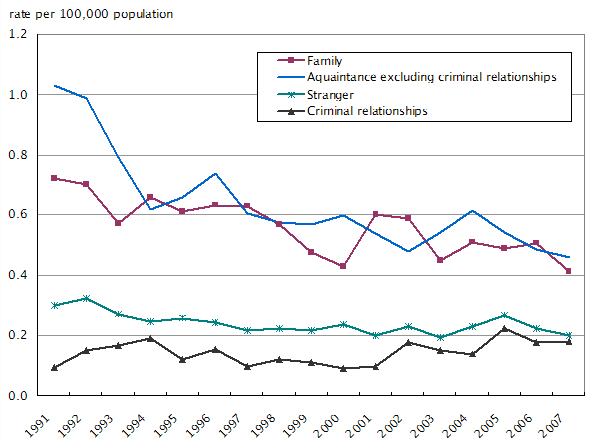
Note: Criminal relationship data unavailable prior to 1991.
Source: Statistics Canada, Canadian Centre for Justice Statistics, Homicide Survey.
Spousal homicides continue to decline
The rate of spousal homicide has been declining since the mid-1970s. This trend continued in 2007, with 13 fewer spousal homicides than in 2006. The spousal homicide rate is now at its lowest point since the mid-1960s. (Chart 8)
Women continue to be about 4 times more likely to be victims of spousal5 homicide than men. In 2007, there were 51 women and 13 men killed by a current or former spouse. For both men and women, more victims were killed by a common-law spouse than by a legally-married spouse in 2007.
Chart 8
Spousal homicide rate is now at its lowest since the mid-1960s
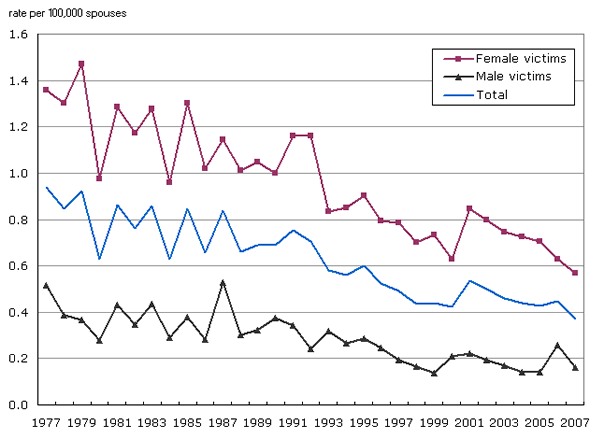
Notes: Spouses include legally married, common-law, separated, and divorced persons age 15 years or older. Excludes same-sex spouses due to the unavailability of Census data on same-sex couples.
Source: Statistics Canada, Canadian Centre for Justice Statistics, Homicide Survey.
Women also continue to be at greater risk than men of being killed by a former spouse. In 2007, 11 of the 51 female spousal victims were killed by a separated or divorced spouse, compared to none of the male victims.
In addition to the 65 spousal homicides,6 there were 16 homicides committed by a current or former boyfriend/girlfriend or intimate partner in 2007, similar to numbers seen in previous years.
Males account for majority of homicide victims and those accused of homicide
As has been the case historically, males accounted for about three-quarters of homicide victims and 9 in 10 accused persons in 2007 (Table 8). Male victims and accused tend to be younger than female victims and accused. In 2007, the median age of male victims was 29.5, compared to 35.5 for female victims. The median age of males accused of homicide was 24 compared to 27 for females accused of homicide.
Males accused of homicide have been getting younger in recent years. The median age of males accused of homicide was down from 29 in 2002 to 24 in 2007, while the age of accused females has remained about the same.
Decline in youth accused of homicide follows peak in 2006
There were 74 youth aged 12 to 17 accused of homicide in 2007, 11 fewer than in 2006 (Table 9). Despite recent fluctuations, the rate of youth accused of homicide has remained relatively stable over the past 30 years. The 2006 rate of youth accused (3.29 per 100,000 youth) was the highest since recording began in 1961. Even though the 2007 rate was lower, it was still the 2nd highest ever recorded.
Compared to adults, a higher proportion of homicides involving youth were gang-related or were incidents where more than one person was accused of committing the crime. Among incidents with an accused youth, 57% involved multiple accused compared to 17% where an adult was accused. Similarly, 32% of incidents with a youth accused involved gangs compared to 11% of incidents with an adult accused.
Homicides committed by youth in 2007 also differed from those committed by adults in the method used. While the most common method employed by a youth to commit homicide was a physical beating (38%), shootings were the most common method used by adults (37%).
Summary
In Canada, homicides are relatively rare, accounting for less than one percent of all violent crime reported to police. Since peaking in 1975, the homicide rate has generally been declining. This trend continued in 2007 with a further 3% decline. Homicide rates fell in most provinces, with Manitoba being the main exception. The 2007 rate in that province was the highest among all the provinces and the highest in Manitoba since statistics were first collected in 1961.
Although there was an overall decline in homicide, gang-related homicides continue to increase, now accounting for about one in five homicides in Canada. Canadian homicide victims are generally at equal risk of either being shot or stabbed, with each method accounting for about one-third of all homicides. The use of handguns to commit homicide continues to rise, while the use of rifles/shotguns continues to decline.
Most homicide victims knew the person who killed them. In 2007, 84% of solved homicides were committed by someone known to the victim. Homicide victims in Canada are as likely to be killed by a family member as they are by an acquaintance – about one-third each. Although the spousal homicide rate fell 18% in 2007, spousal homicides continue to account for just under half of the homicides committed by family members.
After peaking in 2006, the number of youth accused of committing a homicide declined from 85 to 74 in 2007. However, the 2007 rate of youth accused of committing homicide was still the 2nd highest since 1961.
Detailed data tables
Table 1 Homicide rates by province/territory, 1961 to 2007
Table 2 Number of homicides by province/territory, 1961 to 2007
Table 3 Homicides by census metropolitan area (CMA)
Table 4 Methods used to commit homicide, Canada, 1997 to 2007
Table 5 Homicides involving firearms, by type of firearm, Canada, 1997 to 2007
Table 6 Gang-related homicides, by region, 1997 to 2007
Table 7 Solved homicides by accused-victim relationship, Canada
Table 8 Victims of homicide and accused persons, by sex, Canada, 1997 to 2007
Table 9 Youth (12 to 17 years) accused of homicide, Canada, 1997 to 2007
References
de Léséleuc, Sylvain. 2007. Criminal Victimization in the Workplace. Statistics Canada Catalogue no. 85F0033MIE
Dauvergne, Mia. 2008. "Canadian crime statistics, 2007." Juristat. Vol. 28, no. 7. Statistics Canada Catalogue no. 85-002.
Notes
- There were 2,896 deaths resulting from a traffic accident, and 3,613 suicides reported to Statistics Canada, Canadian Vital Statistics - Death Database, in 2004, the latest year for which data are available.
- A census metropolitan area (CMA) refers to a large urban core (at least 100,000 population) together with adjacent urban and rural areas that have a high degree of economic and social integration. The areas that police forces serve may differ in their mix of urban/suburban populations, making the comparability of crime rates among these forces difficult. This lack of comparability is addressed by analyzing crime rates by CMA. Usually, more than one police force is responsible for enforcing the law within the boundaries of a single CMA.
- There were 70 gang-related homicides which were linked to the victims' involvement in illegal activities.
- Of the 15 prostitute homicides reported in 2007, 5 occurred in previous years. Homicides are counted according to the year in which police submit the Homicide Survey to Statistics Canada.
- Including common-law, separated and divorced spouses.
- Including one same-sex partner.
You need to use the free Adobe Reader to view PDF documents. To view (open) these files, simply click on the link. To download (save) them, right-click on the link. Note that if you are using Internet Explorer or AOL, PDF documents sometimes do not open properly. See Troubleshooting PDFs. PDF documents may not be accessible by some devices. For more information, visit the Adobe website or contact us for assistance.
- Date modified:
